安徽医科大学:《病理学 Pathology(MBBS)》课程教学资源(授课教案)
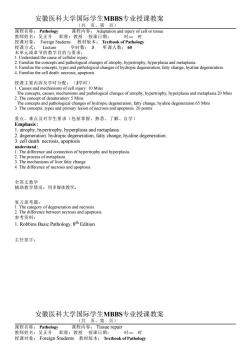
安徽医科大学国际学生MBBS专业授课教案 (共页、第页) 课程名称:Pathology 课程内容:Adaptation and injury of cell or tissue 教师姓名:吴正升职称:教授授课日期: 时一时 授课对象:Foreign Students教材版本:Textbook of Pathology 授课方式:Lecture 学时数:3听课人数:60 本单元或章节的教学目的与要求: 1.Understand the cause of cellular injury. 2.Familiar the concepts and pathological changes of atrophy,hypertrophy,hyperplasia and metaplasia. 3.Familiar the concepts,types and pathological changes of hydropic degeneration,fatty change,hyaline degeneration. 4.Familiar the cell death:necrosis,apoptosis 授课主要内容及学时分配:(3学时) 1.Causes and mechanisms of cell injury:10 Mins The concepts,causes,mechanisms and pathological changes of atrophy,hypertrophy,hyperplasia and metaplasia.20 Mins 2.The concept of denaturation:5 Mins The concepts and pathological changes of hydropic degeneration,fatty change,hyaline degeneration.65 Mins 3.The concepts,types and primary lesion of necrosis and apoptosis.20 points 重点、难点及对学生要求(包括掌握、熟悉、了解、自学) Emphasis: 1.atrophy,hypertrophy,hyperplasia and metaplasia. 2.degeneration:hydropic degeneration,fatty change,hyaline degeneration. 3.cell death:necrosis,apoptosis understand: 1.The difference and connection of hypertrophy and hyperplasia. 2.The process of metaplasia. 3.The mechanisms of liver fatty change. 4.The difference of necrosis and apoptosis. 全英文教学 辅助教学情况:用多媒体教学。 复习思考题: 1.The category of degeneration and necrosis. 2.The difference between necrosis and apoptosis. 参考资料: 1.Robbins Basic Pathology,8th Edition 主任签字: 安徽医科大学国际学生MBBS专业授课教案 (共页、第页) 课程名称:Pathology 课程内容:Tissue repair 教师姓名:吴正升职称:教授授课日期: 时一时 授课对象:Foreign Students教材版本:Textbook of Pathology
安徽医科大学国际学生MBBS专业授课教案 (共 页、第 页) 课程名称: Pathology 课程内容: Adaptation and injury of cell or tissue 教师姓名:吴正升 职称:教授 授课日期: 时— 时 授课对象: Foreign Students 教材版本: Textbook of Pathology 授课方式: Lecture 学时数: 3 听课人数: 60 本单元或章节的教学目的与要求: 1. Understand the cause of cellular injury. 2. Familiar the concepts and pathological changes of atrophy, hypertrophy, hyperplasia and metaplasia. 3. Familiar the concepts, types and pathological changes of hydropic degeneration, fatty change, hyaline degeneration. 4. Familiar the cell death: necrosis, apoptosis 授课主要内容及学时分配:(3学时) 1. Causes and mechanisms of cell injury: 10 Mins The concepts, causes, mechanisms and pathological changes of atrophy, hypertrophy, hyperplasia and metaplasia.20 Mins 2. The concept of denaturation: 5 Mins The concepts and pathological changes of hydropic degeneration, fatty change, hyaline degeneration.65 Mins 3. The concepts, types and primary lesion of necrosis and apoptosis. 20 points 重点、难点及对学生要求(包括掌握、熟悉、了解、自学) Emphasis: 1. atrophy, hypertrophy, hyperplasia and metaplasia. 2. degeneration: hydropic degeneration, fatty change, hyaline degeneration. 3. cell death: necrosis, apoptosis understand: 1. The difference and connection of hypertrophy and hyperplasia. 2. The process of metaplasia. 3. The mechanisms of liver fatty change. 4. The difference of necrosis and apoptosis. 全英文教学 辅助教学情况:用多媒体教学。 复习思考题: 1. The category of degeneration and necrosis. 2. The difference between necrosis and apoptosis. 参考资料: 1. Robbins Basic Pathology, 8th Edition 主任签字: 安徽医科大学国际学生MBBS专业授课教案 (共 页、第 页) 课程名称: Pathology 课程内容: Tissue repair 教师姓名:吴正升 职称:教授 授课日期: 时— 时 授课对象: Foreign Students 教材版本: Textbook of Pathology

授课方式:Lecture 学时数: 听课人数: 本单元或章节的教学目的与要求: 1.Master the concepts of regeneration and repair. 2.Master the ability and pattern of regeneration of various tissues. 3.Understand the process and mechanisms of regeneration. 4.Master the concept,morphological characteristics and function of granulation tissue. 5.Understand the types and basic processes of wound healing 授课主要内容及学时分配:(2学时) 1.The concept of regeneration and repair.10 Mins 2.The ability and pattern of regeneration of various tissues.Mins 3.The process and mechanisms of regeneration.20 Mins 4.The concept,morphological characteristics and function of granulation tissue.20 Mins 5.The types and basic processes of wound healing.20 Mins 重点、难点及对学生要求(包括掌握、熟悉、了解、自学) Emphasis: 1.Regeneration and repair. 2.Regeneration capacity and regeneration mode. 3.Granulation tissue. understand 1.Different cell regeneration ability. 2.The basic process of wound healing:image teaching. 全英文教学 辅助教学情况:用多媒体教学。 复习思考题: 1.The category of different cell types in proliferative potential. 2.What is granulation tissue? 参考资料: 1.Robbins Basic Pathology,8th Edition 主任签字:
授课方式: Lecture 学时数: 听课人数: 本单元或章节的教学目的与要求: 1. Master the concepts of regeneration and repair. 2. Master the ability and pattern of regeneration of various tissues. 3. Understand the process and mechanisms of regeneration. 4. Master the concept, morphological characteristics and function of granulation tissue. 5. Understand the types and basic processes of wound healing. 授课主要内容及学时分配:(2学时) 1. The concept of regeneration and repair. 10 Mins 2. The ability and pattern of regeneration of various tissues. Mins 3. The process and mechanisms of regeneration. 20 Mins 4. The concept, morphological characteristics and function of granulation tissue. 20 Mins 5. The types and basic processes of wound healing. 20 Mins 重点、难点及对学生要求(包括掌握、熟悉、了解、自学) Emphasis: 1. Regeneration and repair. 2. Regeneration capacity and regeneration mode. 3. Granulation tissue. understand: 1. Different cell regeneration ability. 2. The basic process of wound healing: image teaching. 全英文教学 辅助教学情况:用多媒体教学。 复习思考题: 1. The category of different cell types in proliferative potential. 2. What is granulation tissue? 参考资料: 1. Robbins Basic Pathology, 8th Edition 主任签字:
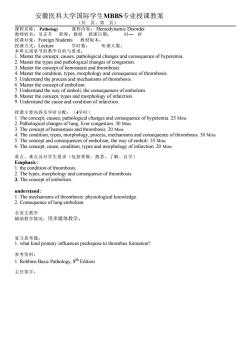
安徽医科大学国际学生MBBS专业授课教案 (共页、第页) 课程名称:Pathology 课程内容:Hemodynamic Disorder 教师姓名:吴正升职称:教授授课日期: 时一时 授课对象:Foreign Students教材版本: 授课方式:Lecture 学时数: 听课人数: 本单元或章节的教学目的与要求: 1.Master the concept,causes,pathological changes and consequence of hyperemia 2.Master the types and pathological changes of congestion. 3.Master the concept of hemostasis and thrombosis. 4.Master the condition,types,morphology and consequence of thrombosis. 5.Understand the process and mechanisms of thrombosis. 6.Master the concept of embolism. 7.Understand the way of emboli,the consequences of embolism. 8.Master the concept,types and morphology of infarction. 9.Understand the cause and condition of infarction. 授课主要内容及学时分配:(4学时) 1.The concept,causes,pathological changes and consequence of hyperemia.25 Mins 2.Pathological changes of lung,liver congestion.30 Mins 3.The concept of hemostasis and thrombosis.20 Mins 4.The condition,types,morphology,process,mechanisms and consequence of thrombosis.30 Mins 5.The concept and consequences of embolism,the way of emboli.35 Mins 6.The concept,cause,condition,types and morphology of infarction.20 Mins 重点、难点及对学生要求(包括掌握、熟悉、了解、自学) Emphasis: 1.the condition of thrombosis. 2.The types,morphology and consequence of thrombosis. 3.The concept of embolism. understand 1.The mechanisms of thrombosis:physiological knowledge. 2.Consequence of lung embolism. 全英文教学 辅助教学情况:用多媒体教学。 复习思考题: 1.what kind primary influences predispose to thrombus formation? 参考资料: 1.Robbins Basic Pathology,8th Edition 主任签字:
安徽医科大学国际学生MBBS专业授课教案 (共 页、第 页) 课程名称: Pathology 课程内容: Hemodynamic Disorder 教师姓名:吴正升 职称:教授 授课日期: 时— 时 授课对象:Foreign Students 教材版本: 授课方式:Lecture 学时数: 听课人数: 本单元或章节的教学目的与要求: 1. Master the concept, causes, pathological changes and consequence of hyperemia. 2. Master the types and pathological changes of congestion. 3. Master the concept of hemostasis and thrombosis. 4. Master the condition, types, morphology and consequence of thrombosis. 5. Understand the process and mechanisms of thrombosis. 6. Master the concept of embolism. 7. Understand the way of emboli, the consequences of embolism. 8. Master the concept, types and morphology of infarction. 9. Understand the cause and condition of infarction. 授课主要内容及学时分配:(4学时) 1. The concept, causes, pathological changes and consequence of hyperemia. 25 Mins 2. Pathological changes of lung, liver congestion. 30 Mins 3. The concept of hemostasis and thrombosis. 20 Mins 4. The condition, types, morphology, process, mechanisms and consequence of thrombosis. 30 Mins 5. The concept and consequences of embolism, the way of emboli. 35 Mins 6. The concept, cause, condition, types and morphology of infarction. 20 Mins 重点、难点及对学生要求(包括掌握、熟悉、了解、自学) Emphasis: 1. the condition of thrombosis. 2. The types, morphology and consequence of thrombosis. 3. The concept of embolism. understand: 1. The mechanisms of thrombosis: physiological knowledge. 2. Consequence of lung embolism. 全英文教学 辅助教学情况:用多媒体教学。 复习思考题: 1. what kind primary influences predispose to thrombus formation? 参考资料: 1. Robbins Basic Pathology, 8th Edition 主任签字:

安徽医科大学国际学生MBBS专业实验课授课教案 (共2页、第1页) 课程名称:pathology experiment 课程内容:inflammation 教师姓名:李延莉职称:1 ecturer授课日期:5/4/201611时50分-14时30分 授课对象:Foreign Students 教材版本:textbook of pathology 授课方式:Lecture 学时数:4听课人数:30 本单元或章节的教学目的与要求: To master basic pathological changes of inflammation. To identify inflammatory cells in the inflammatory tissue and understand significance of them in the process of inflammation. To master morphological changes of various kinds of inflammation,and contact their main clinical manifestations. To learn to use the law of the occurrence and development of inflammation, develop principle of prevention and treatment of inflammatory diseases. 授课主要内容及学时分配: 27#nasal polyp 40 teaching minutes 28#skin scar tissue 40 teaching minutes 33#acute phlegmonous appendicitis 40 teaching minutes 35#multiple abscess of kidney 40 teaching minutes 重点、难点及对学生要求(包括掌握、熟悉、了解、自学) Emphasis: 1.various inflammatory cells 2.granuloma 3.acute phlegmonous appendicitis 4.multiple abscess of kidney understand:fibrinous pericarditis chronic cholecystitis 外语词汇: 全英文教学 辅助教学情况:多媒体 复习思考题: various inflammatory cells ●granuloma acute phlegmonous appendicitis multiple abscess of kidney 安徽医科大学国际学生MBBS专业授课教案 (共2页、第1页) 参考资料: 1.Inflammation:Textbook of Pathology.2005.Zhou Gengyin and Jiang Xucheng. 主任签字:
安徽医科大学国际学生MBBS专业实验课授课教案 (共 2 页、第 1 页) 课程名称:pathology experiment 课程内容:inflammation 教师姓名:李延莉 职称:lecturer 授课日期:5/4/2016 11时50分-14时30分 授课对象:Foreign Students 教材版本:textbook of pathology 授课方式:Lecture 学时数:4 听课人数:30 本单元或章节的教学目的与要求: l To master basic pathological changes of inflammation. l To identify inflammatory cells in the inflammatory tissue and understand significance of them in the process of inflammation. l To master morphological changes of various kinds of inflammation, and contact their main clinical manifestations. l To learn to use the law of the occurrence and development of inflammation, develop principle of prevention and treatment of inflammatory diseases. 授课主要内容及学时分配: l 27# nasal polyp 40 teaching minutes l 28# skin scar tissue 40 teaching minutes l 33# acute phlegmonous appendicitis 40 teaching minutes l 35# multiple abscess of kidney 40 teaching minutes 重点、难点及对学生要求(包括掌握、熟悉、了解、自学) Emphasis: 1. various inflammatory cells 2. granuloma 3. acute phlegmonous appendicitis 4. multiple abscess of kidney understand:fibrinous pericarditis chronic cholecystitis 外语词汇: 全英文教学 辅助教学情况:多媒体 复习思考题: l various inflammatory cells l granuloma l acute phlegmonous appendicitis l multiple abscess of kidney 安徽医科大学国际学生MBBS专业授课教案 (共 2 页、第 1 页) 参考资料: 1. Inflammation: Textbook of Pathology. 2005. Zhou Gengyin and Jiang Xucheng. 主任签字:

安徽医科大学国际学生MBBS专业授课教案 (共页、第页) 课程名称:Pathology 课程内容:Neoplasm 教师姓名:Yongping.Cai职称:Associate Professor授课日期:9/4/2013,10,11时 授课对象:Foreign Students 教材版本::Textbook of pathology 授课方式:Lecture 学时数:9听课人数:90 本单元或章节的教学目的与要求: 1.To master Tumor growth pattern,metastasis. 2.To be familiar with the nomenclature of neoplasm,tumor grading and staging. 3.Have a general understanding of commonly seen tumorigenic agents,the mechanisms of tumor invasion and metastasis. 授课主要内容及学时分配: 1.Theoretical contents and schedule (9 teaching hours) 1)General introduction of neoplasm(0.5 teaching hour) 2)Nomenclature of neoplasm(0.5 teaching hour) 3)Gross appearance of tumor (1 teaching hour) 4)Microscopically feature of tumor:differentiation and anaplasia(1.5 teaching hour) 5)Tumor growth,invasion and metastasis(1.5 teaching hour) 6)Tumor grading and staging(0.5 teaching hour) 7)Effect of tumors on hosts(0.5 teaching hour) 8)Mechanism of neoplasm(1.5 teaching hour) 9)Brief introduction of common neoplasm(1.5 teaching hour) 2.Experimental contents (3 teaching hours) 1)Demonstrate how to recognize papilloma of skin,squamous cell carcinoma,adenoma and adenocarcinoma of colon,lymph node with adenocarcinoma metastasis(1teaching hour) 2) Students observe HE sections (1teaching hour) 3)Show the key feature of gross specimen (0.5 teaching hour) 4)Students observe gross specimen (0.5 teaching hour) 重点、难点及对学生要求(包括掌握、熟悉、了解、自学) Emphasis:
安徽医科大学国际学生MBBS专业授课教案 (共 页、第 页) 课程名称: Pathology 课程内容: Neoplasm 教师姓名:Yongping.Cai 职称:Associate Professor 授课日期:9/4/2013,10,11时 授课对象: Foreign Students 教材版本: :Textbook of pathology 授课方式: Lecture 学时数: 9 听课人数: 90 本单元或章节的教学目的与要求: 1.To master Tumor growth pattern,metastasis. 2.To be familiar with the nomenclature of neoplasm,tumor grading and staging. 3.Have a general understanding of commonly seen tumorigenic agents,the mechanisms of tumor invasion and metastasis. 授课主要内容及学时分配: 1.Theoretical contents and schedule(9 teaching hours) 1)General introduction of neoplasm (0.5 teaching hour) 2)Nomenclature of neoplasm (0.5 teaching hour) 3)Gross appearance of tumor (1 teaching hour) 4)Microscopically feature of tumor:differentiation and anaplasia (1.5 teaching hour) 5)Tumor growth, invasion and metastasis (1.5 teaching hour) 6)Tumor grading and staging (0.5 teaching hour) 7)Effect of tumors on hosts (0.5 teaching hour) 8)Mechanism of neoplasm (1.5 teaching hour) 9)Brief introduction of common neoplasm (1.5 teaching hour) 2.Experimental contents(3 teaching hours) 1) Demonstrate how to recognize papilloma of skin, squamous cell carcinoma, adenoma and adenocarcinoma of colon, lymph node with adenocarcinoma metastasis (1teaching hour) 2) Students observe HE sections (1teaching hour) 3) Show the key feature of gross specimen (0.5 teaching hour) 4) Students observe gross specimen ( 0.5 teaching hour) 重点、难点及对学生要求(包括掌握、熟悉、了解、自学) Emphasis:
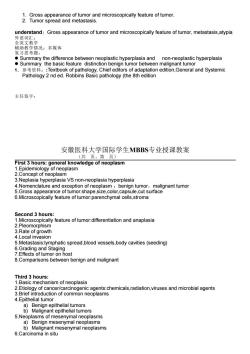
1.Gross appearance of tumor and microscopically feature of tumor. 2.Tumor spread and metastasis. understand:Gross appearance of tumor and microscopically feature of tumor,metastasis,atypia 外语词汇: 全英文教学 辅助教学情况:多媒体 复习思考题: Summary the difference between neoplastic hyperplasia and non-neoplastic hyperplasia Summary the basic feature distinction benign tumor between malignant tumor 1.参考资料::Textbook of pathology,Chief editors of adaptation edition,General and Systemic Pathology 2 nd ed.Robbins Basic pathology(the 8th edition 主任签字: 安徽医科大学国际学生MBBS专业授课教案 (共页、第页) First 3 hours:general knowledge of neoplasm 1.Epidemiology of neoplasm 2.Concept of neoplasm 3.Neplasia hyperplasia VS non-neoplasia hyperplasia 4.Nomenclature and exception of neoplasm benign tumor,malignant tumor 5.Gross appearance of tumor:shape,size,color,capsule,cut surface 6.Microscopically feature of tumor:parenchymal cells,stroma Second 3 hours: 1.Microscopically feature of tumor:differentiation and anaplasia 2.Pleomorphism 3.Rate of growth 4.Local invasion 5.Metastasis:lymphatic spread,blood vessels,body cavities (seeding) 6.Grading and Staging 7.Effects of tumor on host 8.Comparisons between benign and malignant Third 3 hours: 1.Basic mechanism of neoplasia 2.Etiology of cancer/carcinogenic agents:chemicals,radiation,viruses and microbial agents 3.Brief introduction of common neoplasms 4.Epithelial tumor a)Benign epithelial tumors b)Malignant epithelial tumors 5.Neoplasms of mesenymal neoplasms a)Benign mesenymal neoplasms b)Malignant mesenymal neoplasms 6.Carcinoma in situ
1. Gross appearance of tumor and microscopically feature of tumor. 2. Tumor spread and metastasis. understand:Gross appearance of tumor and microscopically feature of tumor, metastasis,atypia 外语词汇: 全英文教学 辅助教学情况:多媒体 复习思考题: l Summary the difference between neoplastic hyperplasia and non-neoplastic hyperplasia l Summary the basic feature distinction benign tumor between malignant tumor 1. 参考资料::Textbook of pathology, Chief editors of adaptation edition,General and Systemic Pathology 2 nd ed. Robbins Basic pathology (the 8th edition 主任签字: 安徽医科大学国际学生MBBS专业授课教案 (共 页、第 页) First 3 hours: general knowledge of neoplasm 1.Epidemiology of neoplasm 2.Concept of neoplasm 3.Neplasia hyperplasia VS non-neoplasia hyperplasia 4.Nomenclature and exception of neoplasm :benign tumor,malignant tumor 5.Gross appearance of tumor:shape,size,color,capsule,cut surface 6.Microscopically feature of tumor:parenchymal cells,stroma Second 3 hours: 1.Microscopically feature of tumor:differentiation and anaplasia 2.Pleomorphism 3.Rate of growth 4.Local invasion 5.Metastasis:lymphatic spread,blood vessels,body cavities (seeding) 6.Grading and Staging 7.Effects of tumor on host 8.Comparisons between benign and malignant Third 3 hours: 1.Basic mechanism of neoplasia 2.Etiology of cancer/carcinogenic agents:chemicals,radiation,viruses and microbial agents 3.Brief introduction of common neoplasms 4.Epithelial tumor a) Benign epithelial tumors b) Malignant epithelial tumors 5.Neoplasms of mesenymal neoplasms a) Benign mesenymal neoplasms b) Malignant mesenymal neoplasms 6.Carcinoma in situ
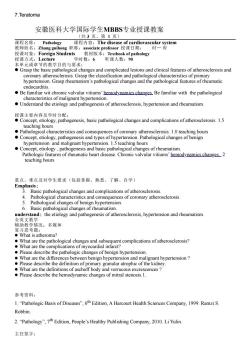
7.Teratoma 安徽医科大学国际学生MBBS专业授课教案 (共3页、第1页) 课程名称: Pathology 课程内容:The disease of cardiovascular system 教师姓名:Zhang guihong职称:associate professor授课日期: 时一时 授课对象:Foreign Students教材版本:Textbook of pathology 授课方式:Lecture 学时数:6听课人数:90 本单元或章节的教学目的与要求: Grasp the basic pathological changes and complicated lesions and clinical features of atherosclerosis and coronary atherosclerosis.Grasp the classification and pathological characteristics of primary hypertension.Grasp rheumatism's pathological changes and the pathological features of rheumatic endocarditis. Be familiar wit chronic valvular vitiums'hemodynamics changes.Be familiar with the pathological characteristics of malignant hypertension. Understand the etiology and pathogenesis of atherosclerosis,hypertension and rheumatism. 授课主要内容及学时分配: Concept,etiology,pathogenesis,basic pathological changes and complications of atherosclerosis.1.5 teaching hours Pathological characteristics and consequences of coronary atherosclerosis.1.0 teaching hours Concept,etiology,pathogenesis and types of hypertension.Pathological changes of benign hypertension and malignant hypertension.1.5 teaching hours Concept,etiology,pathogenesis and basic pathological changes of rheumatism. Pathologic features of rheumatic heart disease.Chronic valvular vitiums'hemodynamics changes.2 teaching hours 重点、难点及对学生要求(包括掌握、熟悉、了解、自学) Emphasis 3.Basic pathological changes and complications of atherosclerosis. 4.Pathological characteristics and consequences of coronary atherosclerosis. 5.Pathological changes of benign hypertension 6.Basic pathological changes of rheumatism. understand:the etiology and pathogenesis of atherosclerosis,hypertension and rheumatism. 全英文教学 辅助教学情况:多媒体 复习思考题: ●What is atheroma? .What are the pathological changes and subsequent complications of atherosclerosis? What are the complications of myocardial infarct? Please describe the pathologic changes of benign hypertension. What are the differences between benign hypertension and malignant hypertension? Please describe the definition of primary granular atrophic of the kidney. What are the definitions of aschoff body and verrucous excrescences Please describe the hemodynamic changes of mitral stenosis.1. 参考资料: 1."Pathologic Basis of Diseases",6th Edition,A Harcourt Health Sciences Company,1999.Ramzi S. Robbin 2."Pathology",7th Edition,People's Healthy Publishing Company,2010.Li Yulin. 主任签字:
7.Teratoma 安徽医科大学国际学生MBBS专业授课教案 (共 3 页、第 1 页) 课程名称: Pathology 课程内容:The disease of cardiovascular system 教师姓名:Zhang guihong 职称:associate professor 授课日期: 时— 时 授课对象:Foreign Students 教材版本:Textbook of pathology 授课方式:Lecture 学时数:6 听课人数:90 本单元或章节的教学目的与要求: l Grasp the basic pathological changes and complicated lesions and clinical features of atherosclerosis and coronary atherosclerosis. Grasp the classification and pathological characteristics of primary hypertension. Grasp rheumatism’s pathological changes and the pathological features of rheumatic endocarditis. l Be familiar wit chronic valvular vitiums’ hemodynamics changes. Be familiar with the pathological characteristics of malignant hypertension. l Understand the etiology and pathogenesis of atherosclerosis, hypertension and rheumatism. 授课主要内容及学时分配: l Concept, etiology, pathogenesis, basic pathological changes and complications of atherosclerosis. 1.5 teaching hours l Pathological characteristics and consequences of coronary atherosclerosis. 1.0 teaching hours l Concept, etiology, pathogenesis and types of hypertension. Pathological changes of benign hypertension and malignant hypertension. 1.5 teaching hours l Concept, etiology , pathogenesis and basic pathological changes of rheumatism. Pathologic features of rheumatic heart disease. Chronic valvular vitiums’ hemodynamics changes. 2 teaching hours 重点、难点及对学生要求(包括掌握、熟悉、了解、自学) Emphasis: 3. Basic pathological changes and complications of atherosclerosis. 4. Pathological characteristics and consequences of coronary atherosclerosis. 5. Pathological changes of benign hypertension. 6. Basic pathological changes of rheumatism. understand:the etiology and pathogenesis of atherosclerosis, hypertension and rheumatism. 全英文教学 辅助教学情况:多媒体 复习思考题: l What is atheroma? l What are the pathological changes and subsequent complications of atherosclerosis? l What are the complications of myocardial infarct? l Please describe the pathologic changes of benign hypertension. l What are the differences between benign hypertension and malignant hypertension ? l Please describe the definition of primary granular atrophic of the kidney. l What are the definitions of aschoff body and verrucous excrescences ? l Please describe the hemodynamic changes of mitral stenosis.1. 参考资料: 1. “Pathologic Basis of Diseases”, 6th Edition, A Harcourt Health Sciences Company, 1999. Ramzi S. Robbin. 2. “Pathology”, 7th Edition, People’s Healthy Publishing Company, 2010. Li Yulin. 主任签字:

安徽医科大学国际学生MBBS专业授课教案 (共3页、第3页) First 3 hours:general knowledge of tuberculosis 1.Introduction of infectious diseases 2.Concept,etiology,and pathogenesis of tuberculosis 3.Basic pathological changes and transformation of tuberculosis 4.The pathogenesis,development,characteristics of different types,relationship of pathological characteristics to clinical manifestations of primary and secondary pulmonary tuberculosis 5.The characteristics of extrapulmonary tuberculosis(intestine,peritoneum,meninges,urinogenital system, bone and joint,lymph nodes) Sencond 1.5 hours:Typhoid fever and Bacillary dysentery 1.The etiology,pathogenesis and infectious routes of typhoid fever 2.Pathological changes of typhoid fever 3.The etiology,pathogenesis and infectious routes of bacillary dysentery 4.Pathological features and clinical manifestations of bacillary dysentery Thrid 1.5 hours:Epidemic cerebrospinal meningitis and Epidemic encephalitis B 1.The etiology,pathogenesis and infectious routes of epidemic cerebrospinal meningitis 2.The basic pathological changes of epidemic cerebrospinal meningitis 3.Pathogenesis and infectious routes of epidemic encephalitis B 4.Pathological features and clinical manifestations of epidemic encephalitis B 安徽医科大学国际学生MBBS专业授课教案 课程名称:Pathology 课程内容:respiratory system diseases 教师姓名:Caili职称:associate professor授课日期:12/4/2016,14,15 授课对象:Foreign Students教材版本:Pathology 授课方式:Lecture 学时数:6听课人数:90 本单元或章节的教学目的与要求: Understand the pathological changes of lobar/lobular pneumonia and COPD Familiar the pathology and clinical features of lung carcinoma Be able to differentiate lobar and lobular pneumonia
安徽医科大学国际学生MBBS专业授课教案 (共 3 页、第 3 页) First 3 hours: general knowledge of tuberculosis 1. Introduction of infectious diseases 2. Concept, etiology, and pathogenesis of tuberculosis 3. Basic pathological changes and transformation of tuberculosis 4. The pathogenesis, development, characteristics of different types, relationship of pathological characteristics to clinical manifestations of primary and secondary pulmonary tuberculosis 5.The characteristics of extrapulmonary tuberculosis (intestine, peritoneum, meninges, urinogenital system, bone and joint, lymph nodes) Sencond 1.5 hours: Typhoid fever and Bacillary dysentery 1. The etiology, pathogenesis and infectious routes of typhoid fever 2. Pathological changes of typhoid fever 3. The etiology, pathogenesis and infectious routes of bacillary dysentery 4. Pathological features and clinical manifestations of bacillary dysentery Thrid 1.5 hours: Epidemic cerebrospinal meningitis and Epidemic encephalitis B 1. The etiology, pathogenesis and infectious routes of epidemic cerebrospinal meningitis 2. The basic pathological changes of epidemic cerebrospinal meningitis 3. Pathogenesis and infectious routes of epidemic encephalitis B 4. Pathological features and clinical manifestations of epidemic encephalitis B 安徽医科大学国际学生MBBS专业授课教案 课程名称: Pathology 课程内容:respiratory system diseases 教师姓名:Caili 职称:associate professor 授课日期:12/4/2016,14,15 授课对象:Foreign Students 教材版本:Pathology 授课方式:Lecture 学时数:6 听课人数:90 本单元或章节的教学目的与要求: l Understand the pathological changes of lobar/lobular pneumonia and COPD l Familiar the pathology and clinical features of lung carcinoma l Be able to differentiate lobar and lobular pneumonia
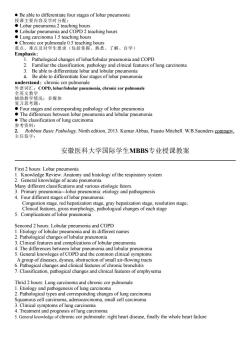
Be able to differentiate four stages of lobar pneumonia 授课主要内容及学时分配: Lobar pneumonia 2 teaching hours Lobular pneumonia and COPD 2 teaching hours Lung carcinoma 1.5 teaching hours Chronic cor pulmonale 0.5 teaching hours 重点、难点及对学生要求(包括掌握、熟悉、了解、自学) Emphasis: 1. Pathological changes of lobar/lobular pneumonia and COPD 2.Familiar the classification,pathology and clinical features of lung carcinoma 3.Be able to differentiate lobar and lobular pneumonia 4.Be able to differentiate four stages of lobar pneumonia understand:chronic cor pulmonale 外语词汇:COPD,lobar/lobular pneumonia,chronic cor pulmonale 全英文教学 辅助教学情况:多媒体 复习思考题: Four stages and corresponding pathology of lobar pneumonia The differences between lobar pneumonia and lobular pneumonia The classification of lung carcinoma 参考资料: 2.Robbins Basic Pathology,Ninth edition,2013.Kumar Abbas,Fausto Mitchell.W.B.Saunders company. 主任签字: 安徽医科大学国际学生MBBS专业授课教案 First 2 hours:Lobar pneumonia 1.Knowledge Review:Anatomy and histology of the respiratory system 2.General knowledge of acute pneumonia Many different classifications and various etiologic fators. 3.Primary pneumonia---lobar pneumonia:etiology and pathogenesis 4.Four different stages of lobar pneumonia: Congestion stage,red hepatization stage,gray hepatization stage,resolution stage; Clinical features,gross morphology,pathological changes of each stage 5.Complications of lobar pneumonia Sencond 2 hours:Lobular pneumonia and COPD 1.Etiology of lobular pneumonia and its different names 2.Pathological changes of lobular pneumonia 3.Clinical features and complications of lobular pneumonia 4.The differences between lobar pneumonia and lobular pneumonia 5.General knowleges of COPD and the common clinical symptoms A group of diseases,dysnea,obstruction of small air-flowing tracts 6.Pathogical changes and clinical features of chronic bronchitis 7.Classification,pathogical changes and clinical features of emphysema Thrid 2 hours:Lung carcinoma and chronic cor pulmonale 1.Etiology and pathogenesis of lung carcinoma 2.Pathological types and corresponding changes of lung carcinoma Squamous cell carcinoma,adenocarcinoma,small cell carcinoma 3.Clinical symptoms of lung carcinoma 4.Treatment and prognosis of lung carcinoma 5.General knowledge of chronic cor pulmonale:right heart disease,finally the whole heart failure
l Be able to differentiate four stages of lobar pneumonia 授课主要内容及学时分配: l Lobar pneumonia 2 teaching hours l Lobular pneumonia and COPD 2 teaching hours l Lung carcinoma 1.5 teaching hours l Chronic cor pulmonale 0.5 teaching hours 重点、难点及对学生要求(包括掌握、熟悉、了解、自学) Emphasis: 1. Pathological changes of lobar/lobular pneumonia and COPD 2. Familiar the classification, pathology and clinical features of lung carcinoma 3. Be able to differentiate lobar and lobular pneumonia 4. Be able to differentiate four stages of lobar pneumonia understand:chronic cor pulmonale 外语词汇:COPD, lobar/lobular pneumonia, chronic cor pulmonale 全英文教学 辅助教学情况:多媒体 复习思考题: l Four stages and corresponding pathology of lobar pneumonia l The differences between lobar pneumonia and lobular pneumonia l The classification of lung carcinoma 参考资料: 2. Robbins Basic Pathology, Ninth edition, 2013. Kumar Abbas, Fausto Mitchell. W.B.Saunders company. 主任签字: 安徽医科大学国际学生MBBS专业授课教案 First 2 hours: Lobar pneumonia 1. Knowledge Review: Anatomy and histology of the respiratory system 2. General knowledge of acute pneumonia Many different classifications and various etiologic fators. 3. Primary pneumonia---lobar pneumonia: etiology and pathogenesis 4. Four different stages of lobar pneumonia: Congestion stage, red hepatization stage, gray hepatization stage, resolution stage; Clinical features, gross morphology, pathological changes of each stage 5. Complications of lobar pneumonia Sencond 2 hours: Lobular pneumonia and COPD 1. Etiology of lobular pneumonia and its different names 2. Pathological changes of lobular pneumonia 3. Clinical features and complications of lobular pneumonia 4. The differences between lobar pneumonia and lobular pneumonia 5. General knowleges of COPD and the common clinical symptoms A group of diseases, dysnea, obstruction of small air-flowing tracts 6. Pathogical changes and clinical features of chronic bronchitis 7. Classification, pathogical changes and clinical features of emphysema Thrid 2 hours: Lung carcinoma and chronic cor pulmonale 1. Etiology and pathogenesis of lung carcinoma 2. Pathological types and corresponding changes of lung carcinoma Squamous cell carcinoma, adenocarcinoma, small cell carcinoma 3. Clinical symptoms of lung carcinoma 4. Treatment and prognosis of lung carcinoma 5. General knowledge of chronic cor pulmonale: right heart disease, finally the whole heart failure
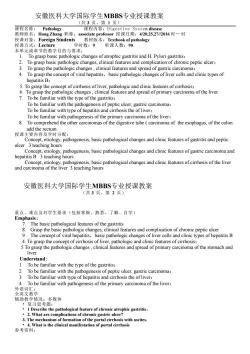
安徽医科大学国际学生MBBS专业授课教案 (共3页、第1页) 课程名称:Pathology 课程内容:Digestive System disease 教师姓名:Hong Zhang职称:associate professor授课日期:4/20,25,27/2016时一时 授课对象:Foreign Students教材版本:Textbook of pathology 授课方式:Lecture 学时数:9听课人数:90 本单元或章节的教学目的与要求: 1.To grasp basic pathologic changes of atrophic gastritis and H.Pylori gastritis; 2.To grasp basic pathologic changes,clinical features and complication of chronic peptic ulcer: 3.To grasp the pathologic changes,clinical features and spread of gastric carcinoma: 4.To grasp the concept of viral hepatitis,basic pathologic changes of liver cells and clinic types of hepatitis B; 5.To grasp the concept of cirrhosis of liver,pathologic and clinic features of cirrhosis: 6.To grasp the pathologic changes,clinical features and spread of primary carcinoma of the liver. 7.To be familiar with the type of the gastritis; To be familiar with the pathogenesis of peptic ulcer,gastric carcinoma: To be familiar with type of hepatitis and cirrhosis the of liver; To be familiar with pathogenesis of the primary carcinoma of the liver: 8.To comprehend the other carcinomas of the digestive tube carcinoma of the esophagus,of the colon add the rectum. 授课主要内容及学时分配: Concept,etiology,pathogenesis,basic pathological changes and clinic features of gastritis and peptic ulcer 3 teaching hours Concept,etiology,pathogenesis,basic pathological changes and clinic features of gastric carcinoma and hepatitis B 3 teaching hours Concept,etiology,pathogenesis,basic pathological changes and clinic features of cirrhosis of the liver and carcinoma of the liver 3 teaching hours 安徽医科大学国际学生MBBS专业授课教案 (共3页、第2页) 重点、难点及对学生要求(包括掌握、熟悉、了解、自学) Emphasis: 7.The basic pathological features of the gastritis 8. Grasp the basic pathologic changes,clinical features and complication of chronic peptic ulcer 9.The concept of viral hepatitis,basic pathologic changes of liver cells and clinic types of hepatitis B 4.To grasp the concept of cirrhosis of liver,pathologic and clinic features of cirrhosis: 5 To grasp the pathologic changes,clinical features and spread of primary carcinoma of the stomach and liver. Understand: 1 To be familiar with the type of the gastritis: 2 To be familiar with the pathogenesis of peptic ulcer,gastric carcinoma; 3 To be familiar with type of hepatitis and cirrhosis the of liver; 4 To be familiar with pathogenesis of the primary carcinoma of the liver; 外语词汇: 全英文教学 辅助教学情况:多媒体 ·复习思考题: 1 Describe the pathological feature of chronic atrophic gastritis. 2.What are complications of chronic gastric ulcer? 3.The mechanism of formation of the portal cirrhosis with ascites. 4.What is the clinical manifestation of portal cirrhosis 参考资料:
安徽医科大学国际学生MBBS专业授课教案 (共 3 页、第 1 页) 课程名称: Pathology 课程内容:Digestive System disease 教师姓名:Hong Zhang 职称:associate professor 授课日期:4/20,25,27//2016 时— 时 授课对象:Foreign Students 教材版本:Textbook of pathology 授课方式:Lecture 学时数:9 听课人数:90 本单元或章节的教学目的与要求: 1. To grasp basic pathologic changes of atrophic gastritis and H. Pylori gastritis; 2. To grasp basic pathologic changes, clinical features and complication of chronic peptic ulcer; 3. To grasp the pathologic changes , clinical features and spread of gastric carcinoma; 4. To grasp the concept of viral hepatitis,basic pathologic changes of liver cells and clinic types of hepatitis B; 5. To grasp the concept of cirrhosis of liver, pathologic and clinic features of cirrhosis; 6. To grasp the pathologic changes , clinical features and spread of primary carcinoma of the liver. 7. To be familiar with the type of the gastritis; To be familiar with the pathogenesis of peptic ulcer, gastric carcinoma; To be familiar with type of hepatitis and cirrhosis the of liver; To be familiar with pathogenesis of the primary carcinoma of the liver; 8. To comprehend the other carcinomas of the digestive tube ( carcinoma of the esophagus, of the colon add the rectum. 授课主要内容及学时分配: Concept, etiology, pathogenesis, basic pathological changes and clinic features of gastritis and peptic ulcer 3 teaching hours Concept, etiology, pathogenesis, basic pathological changes and clinic features of gastric carcinoma and hepatitis B 3 teaching hours Concept, etiology, pathogenesis, basic pathological changes and clinic features of cirrhosis of the liver and carcinoma of the liver 3 teaching hours 安徽医科大学国际学生MBBS专业授课教案 (共 3 页、第 2 页) 重点、难点及对学生要求(包括掌握、熟悉、了解、自学) Emphasis: 7. The basic pathological features of the gastritis 8. Grasp the basic pathologic changes, clinical features and complication of chronic peptic ulcer 9. The concept of viral hepatitis,basic pathologic changes of liver cells and clinic types of hepatitis B 4. To grasp the concept of cirrhosis of liver, pathologic and clinic features of cirrhosis; 5 To grasp the pathologic changes , clinical features and spread of primary carcinoma of the stomach and liver. Understand: 1 To be familiar with the type of the gastritis; 2 To be familiar with the pathogenesis of peptic ulcer, gastric carcinoma; 3 To be familiar with type of hepatitis and cirrhosis the of liver; 4 To be familiar with pathogenesis of the primary carcinoma of the liver; 外语词汇: 全英文教学 辅助教学情况:多媒体 • 复习思考题: • 1 Describe the pathological feature of chronic atrophic gastritis。 • 2. What are complications of chronic gastric ulcer? 3. The mechanism of formation of the portal cirrhosis with ascites. • 4. What is the clinical manifestation of portal cirrhosis 参考资料:
按次数下载不扣除下载券;
注册用户24小时内重复下载只扣除一次;
顺序:VIP每日次数-->可用次数-->下载券;
- 安徽医科大学:《病理学 Pathology(MBBS)》课程教学资源(教学大纲).pdf
- 安徽医科大学:《生殖医学基础与临床》课程教学资源(PPT课件讲稿)辅助生殖技术并发 The prevention and treatment of complications related to ART(主讲:许孝凤).ppt
- 安徽医科大学:《生殖医学基础与临床》课程教学资源(PPT课件讲稿)男性不育诊治方法与进展(主讲:贺小进).ppt
- 安徽医科大学:《生殖医学基础与临床》课程教学资源(PPT课件讲稿)圆头精子症受精失败机理、对策及其基因诊断平台的建立(主讲:朱复希).ppt
- 安徽医科大学:《生殖医学基础与临床》课程教学资源(PPT课件讲稿)多囊卵巢综合征(PCOS)Polycystic Ovarian Syndrome(主讲:徐玉萍).ppt
- 安徽医科大学:《生殖医学基础与临床》课程教学资源(PPT课件讲稿)5例无头精子症家系的临床分析和治疗对策(主讲:朱复希).ppt
- 安徽医科大学:《生殖医学基础与临床》课程教学资源(PPT课件讲稿)胚胎实验室的质量控制与管理(主讲:周平).ppt
- 安徽医科大学:《生殖医学基础与临床》课程教学资源(PPT课件讲稿)未成熟卵体外培养技术及其应用(主讲:邢琼).pptx
- 安徽医科大学:《生殖医学基础与临床》课程教学资源(PPT课件讲稿)人工授精 artificial insemination(主讲:邹薇薇).pptx
- 安徽医科大学:《生殖医学基础与临床》课程教学资源(PPT课件讲稿)辅助生殖伦理的基本常识与基本原则(主讲:周平).pptx
- 安徽医科大学:《生殖医学基础与临床》课程教学资源(电子教案)生殖医学相关的分子生物技术.doc
- 安徽医科大学:《生殖医学基础与临床》课程教学资源(PPT课件讲稿)人类配子、胚胎和性腺组织的冷冻(主讲:郝燕).pptx
- 安徽医科大学:《生殖医学基础与临床》课程教学资源(PPT课件讲稿)胚胎的培养(主讲:章志国).pptx
- 安徽医科大学:《生殖医学基础与临床》课程教学资源(PPT课件讲稿)精子发生的分子机制(主讲:朱复希).ppt
- 安徽医科大学:《生殖医学基础与临床》课程教学资源(PPT课件讲稿)转基因技术 Genetically modified animals(主讲:章志国).pptx
- 安徽医科大学:《毒理学基础》课程教学资源(试卷习题)复习题二.doc
- 安徽医科大学:《毒理学基础》课程教学资源(试卷习题)第十一章 管理毒理学(含答案).doc
- 安徽医科大学:《毒理学基础》课程教学资源(试卷习题)复习题一.doc
- 安徽医科大学:《毒理学基础》课程教学资源(试卷习题)第八章_外源化学物致癌作用(含答案).doc
- 安徽医科大学:《毒理学基础》课程教学资源(试卷习题)第九章 发育毒性与致畸作用(含答案).doc
- 安徽医科大学:《医学微生物学》课程教学大纲 Medical microbiology(负责人:黄升海).pdf
- 安徽医科大学:《医学微生物学》课程教学授课教案 Medical microbiology.docx
- 安徽医科大学:《医学微生物学》课程PPT教学课件(理论课)01 绪论、细菌的形态结构(主讲:刘伯玉).ppt
- 安徽医科大学:《医学微生物学》课程PPT教学课件(理论课)02 细菌的生理、消毒灭菌与实验室安全、细菌的遗传和变异.ppt
- 安徽医科大学:《医学微生物学》课程PPT教学课件(理论课)03 细菌的感染与免疫、细菌感染的诊断与防治原则.ppt
- 安徽医科大学:《医学微生物学》课程PPT教学课件(理论课)04 球菌、肠道杆菌.ppt
- 安徽医科大学:《医学微生物学》课程PPT教学课件(理论课)10 螺旋体 Spirochete.ppt
- 安徽医科大学:《医学微生物学》课程PPT教学课件(理论课)05 弧菌属、空肠弯曲菌和幽门螺杆菌、厌氧性细菌、棒状杆菌属.ppt
- 安徽医科大学:《医学微生物学》课程PPT教学课件(理论课)06 分枝杆菌属、微小杆菌.ppt
- 安徽医科大学:《医学微生物学》课程PPT教学课件(理论课)07 支原体 Mycoplasma.ppt
- 安徽医科大学:《医学微生物学》课程PPT教学课件(理论课)08 立克次体 Rickettsiae.pptx
- 安徽医科大学:《医学微生物学》课程PPT教学课件(理论课)09 衣原体 Chlamydia.ppt
- 安徽医科大学:《医学微生物学》课程PPT教学课件(理论课)11 病毒的基本性状 General Properties of Viruses.ppt
- 安徽医科大学:《医学微生物学》课程PPT教学课件(理论课)12 病毒感染与免疫 Viral Infection and Immunity.ppt
- 安徽医科大学:《医学微生物学》课程PPT教学课件(理论课)13 病毒感染的检查方法及防治原则.ppt
- 安徽医科大学:《医学微生物学》课程PPT教学课件(理论课)14 呼吸道病毒 Respiratory Viruses.ppt
- 安徽医科大学:《医学微生物学》课程PPT教学课件(理论课)15 肠道病毒 Enteroviruses.ppt
- 安徽医科大学:《医学微生物学》课程PPT教学课件(理论课)16 急性胃肠炎病毒 Acute Gastroenteritis Viruses.ppt
- 安徽医科大学:《医学微生物学》课程PPT教学课件(理论课)17 肝炎病毒 Hepatitis viruses.ppt
- 安徽医科大学:《医学微生物学》课程PPT教学课件(理论课)18 虫媒病毒、出血热病毒.ppt
